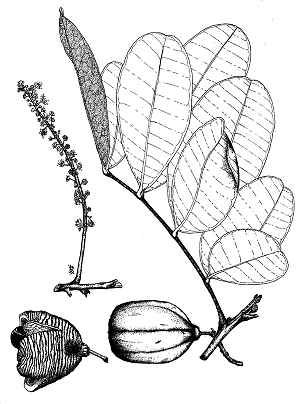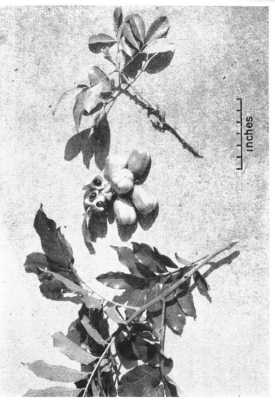USDA: 10b-12
Frost Tolerance: Hardy to 32°F (0°C) for short periods, mature trees are reported having survived 26°F (-3°C)
Sun Exposure: Light shade to full sun
Origin: Western Africa
Growth Habits: Evergreen tree
Watering Needs: Regular water
Propagation: Seeds, shield budding

Ackee (Blighia sapida), U.S.D.A. Drawing, courtesy Hunt Institute
The Akee is native to western tropical Africa and was introduced into Jamaica in the late 18th century. It has spread to other parts of tropical America but is still more widely grown in Jamaica than elsewhere. The tree is medium-sized and evergreen. The odd-pinnately compound leaves have 3 to 5 pairs of dark-green, obovate-oblong leaflets.
Blooming Habits:
The small, greenish-white, fragrant flowers are produced laterally in racemes.
Fruiting Habits:
The trivalved fruits turn yellow and red as they ripen. The mature fruit splits open along 3 sutures exposing the 3 large, shiny, black seeds attached to a white or milky-white aril. The firm and oily aril is the edible portion and is consumed fresh or is cooked and used as a vegetable.
Great care must be exercised in using this fruit, since both immature and overmature fruits may be toxic. Two peptides that proved to be toxic to animals have been isolated from unripe seeds of the akee. One of these, hypoglycin A, also occurs in the edible portion, the concentration being particularly high when the aril is not fully ripe. Only naturally opened fruits should be eaten, and care should be taken to remove the pink or purplish membrane near the seed.
Culture:
The akee grows satisfactorily on a wide range of soil types but makes best growth on loams well supplied with moisture. It is propagated readily by seeds; the seedlings begin to bear in about 5 years.
Desert-Tropicals is dedicated to provide gardening advice, gardening ideas, and information about flower of all kind for landscape and collections.We try to check carefully the identification of the plants on the illustrations as well as the other information from the page, but occasionally errors do occur. if you notice anything that needs to be changed please contact us.Thanks.
© 1998-2020 Philippe Faucon, All Rights Reserved.
